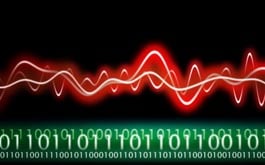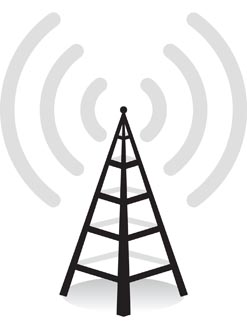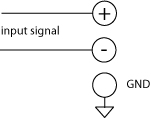Noise is unwanted interference that affects the signal and may distort the information. The designer’s ability to reduce noise relies on an understanding of the source and how it is able to enter the circuit. Noise comes from a variety of sources. Some comes from inside a circuit or device, and some from outside. What creates this noise? Motors generate noise and fluorescent lighting generates noise. Noise gets into a circuit from outside through two fundamentally different ways:
- Radiated – like an antenna
- Conducted – on wires

Noise – unwanted interference that may distort the information
Radiated Noise
Radiated noise travels through the air as radio waves. Radiated noise might come from a radio stations, radar, or near by equipment like your PC. This noise couples into a circuit or passes through an enclosure efficiently when the dimensions of the circuit or the hole in the enclosure are close to 1/4 the wavelength of the noise or larger. Below 1/4 wavelength the coupling drops off rapidly. Here are wavelengths for various frequencies:
- 1 KHz – 190 miles
- 1 MHz – 1000 feet
- 1 GHz – 1 foot
For most circuits, the radiated noise is mainly a problem above 100 MHz, although AM radio stations (near 1 MHz) can induce significant noise in a circuit if there are long wires. If your PC is not well-shielded, noise can radiate out from your computer and interfere with measurements. Modern PCs generate a lot of high frequency noise in the gigahertz range, which must be contained by the enclosure. Radar isn’t so common, but sometimes you’ll see it if you are near an airport or if you are near a radar installation. What you’ll find is a pulse of noise and then nothing, and then another pulse of noise, as the radar spins around and hits you.
 Radiated Noise
Radiated Noise
Metal enclosures and shielded cables are effective at reducing radiated noise. The best place to reduce it is at the source, such as a PC. You can also protect your device from receiving the noise. To reduce radiated noise, you need to ensure that enclosure openings are small. A quarter of the wavelength is the most efficient size for an opening; below that size you still have something. If you are 10 times or 100 times smaller then it’s pretty much gone. You must pay attention to openings in the enclosures for the data acquisition unit, the equipment that you are measuring, and other nearby electronic equipment like computers. You can also shield wires. If you are dealing with small signals that can easily pick up noise, they should be shielded very carefully. Besides reducing enclosure openings and shielding, filters are an effective way to reduce radiated noise. A filter that only passes signals below the megahertz range will eliminate most radiated noise. But if you are measuring signals that are higher frequency, radiated noise can be a big problem. Even measuring vibration at 10 kilohertz you may have to use enclosures, shielding and filtering to get rid of surrounding high-frequency radiated noise.
Recently, a client was taking some temperature calibration measurements and could not get repeatable measurements. After trying many things to reduce noise, they moved the system to a different room away from their server closet. The problem went away. Moving the testing system away is a very effective solution, because the radiated noise drops with the square of the distance. Doubling the distance from the noise source reduces the noise by a factor of 4.
Conducted Noise
Conducted noise gets into a circuit on wires. These can be the signal wires picking up the measured signal, or they can be the power supply wires. In addition to high frequency noise there is power line frequency noise, which is usually 50Hz or 60Hz. Normally power line noise does not get into a system through the power supply. Higher frequencies on the power line are a common problem. These can be generated by motors or any device that has arcing. An arc welder generates a lot of conducted noise on the power line, but fortunately you won’t usually have one nearby. Noise can be coupled into signal wires from power lines that run throughout most buildings. Battery operated devices avoid most noise from the power supply wires.
Shielding, filtering and the use of twisted pair wires on differential signal inputs reduce conducted noise. Filters on the power inputs and signal inputs can reduce conducted noise. Shielding keeps the noise out so it doesn’t have to be filtered. If the signal being measured changes slowly, like temperature, the filter can have a low cut-off frequency. This makes it relatively easy to measure microvolt level signals from thermocouples, for example. Signals such as accelerometers are often measured at 10 KHz, so the filtering cannot reduce as much noise.
Inputs into a typical data acquisition system come in two types: single-ended inputs and differential inputs. For a signal-ended input, the signal is measured between one input and ground. A differential input measures between two inputs, neither of which is grounded. Among other advantages a signal at a differential input can run through a twisted pair wire where both wires pick up the noise equally and the noise cancels out. While it’s not perfect, you can reduce the noise a great deal. Twisted pair differential inputs, filtering and shielded wires are effective ways to reduce conducted noise.

Single-ended Inputs
We had a test system that worked fine most of the time, but sometimes it had erratic results. After studying the problem and trying various fixes, we discovered that the problem usually happened in the afternoon, but not every day. There was a motorcycle parts company in the same building, which occasionally did arc welding. When we discovered that they only did welding in the afternoon, we were able to verify that this problem occurred when they were operating the arc welder. Even though they used a separate electrical circuit, the noise still coupled through the power line into our equipment. To reduce noise, we made mutually agreeable arrangements to avoid testing when they were arc welding. The only other practical solution would have been to move the testing to another building.

Differential Inputs
Summary
Analysis can only be as good as the input data. Careful acquisition is required to provide high quality data. This paper explores how to reduce noise of two different types: radiated and conducted. The noise gets into equipment or affects measurements. Some other topics covered are common types of noise and techniques that are effective ways to reduce unwanted signals.